Experimental and DIC Study of Reinforced Concrete Beams Strengthened by Basalt and Carbon Textile Reinforced Mortars in Flexure
Abstract
:1. Introduction and Background
2. Experimental Programme
2.1. Description of the Test Specimens
2.2. Textile-Reinforced Mortar Properties
2.2.1. Textile Fibres
2.2.2. Polymer Cement Mortar
2.3. TRM Casting Method
Surface Preparation
3. Experimental Setup and Loading Method
3.1. Digital Image Correlation
4. Results and Discussion
4.1. Load-Deflection Characteristics of the Tested Specimens
4.2. Load Capacity Improvement from Basalt and Carbon TRMs
4.3. Ductility Index
4.4. Energy Absorption Capacity
4.5. Cracking and Failure Modes
4.6. Flexural Stiffness
4.7. Digital Image Correlation
4.7.1. DIC Crack Width
4.7.2. DIC Crack Pattern
4.7.3. Experimental Deflection versus DIC Deflection
5. Conclusions
Author Contributions
Funding
Data Availability Statement
Acknowledgments
Conflicts of Interest
Notations and Abbreviations
| U-Wrap | TRM shaped into U to strengthen beam ends |
| TRC | Textile-reinforced concrete |
| FRCM | Fibre-reinforced cementitious matrix |
| TRM | Textile-reinforced mortar |
| PBO | Polyparaphenylene benzobisoxazole |
| BTRM/CTRM | Basalt/Carbon textile-reinforced mortar |
| DIC | Digital image correlation |
| B-1L,3L,5L | Basalt TRM with one, three and five layers of textile |
| C-1L,3L-5L | Carbon TRM with one, three and five layers of textile |
| DI | Ductility index |
| εxx | DIC strain |
| EI | Flexural stiffness |
| Ψ | Energy absorption index |
References
- Park, J.; You, J.; Park, S.-K.; Hong, S. Flexural Behavior of Textile Reinforced Mortar-Strengthened Reinforced Concrete Beams Subjected to Cyclic Loading. Buildings 2022, 12, 1738. [Google Scholar] [CrossRef]
- Cai, G.; Tsavdaridis, K.D.; Si Larbi, A.; Purnell, P. A simplified design approach for predicting the flexural behavior of TRM-strengthened RC beams under cyclic loads. Constr. Build. Mater. 2021, 285, 122799. [Google Scholar] [CrossRef]
- Du, Y.X.; Shao, X.; Chu, S.H.; Zhou, F.; Su, R.K.L. Strengthening of preloaded RC beams using prestressed carbon textile reinforced mortar plates. Structures 2021, 30, 735–744. [Google Scholar] [CrossRef]
- Koutas Lampros, N.; Bournas Dionysios, A. Flexural Strengthening of Two-Way RC Slabs with Cut Openings Using Textile-Reinforced Mortar Composites. J. Compos. Constr. 2021, 25, 04021018. [Google Scholar] [CrossRef]
- Ombres, L. Flexural analysis of reinforced concrete beams strengthened with a cement based high strength composite material. Compos. Struct. 2011, 94, 143–155. [Google Scholar] [CrossRef]
- Ombres, L. Debonding analysis of reinforced concrete beams strengthened with fibre reinforced cementitious mortar. Eng. Fract. Mech. 2012, 81, 94–109. [Google Scholar] [CrossRef]
- Brückner, A.; Ortlepp, R.; Curbach, M. Textile reinforced concrete for strengthening in bending and shear. Mater. Struct. 2006, 39, 741–748. [Google Scholar] [CrossRef]
- Triantafillou, T.; Papanicolaou, C. Shear Strengthening of RC Members with Textile Reinforced Mortar (TRM) Jackets. Mater. Struct. 2006, 39, 93–103. [Google Scholar] [CrossRef]
- Oluwadahunsi, S.; Moy, C.K.S. Performance of Corroded Reinforced-Concrete Beams in Flexure Strengthened Using Different Basalt Fiber Textile-Reinforced Mortar Schemes. J. Compos. Constr. 2020, 24, 04020061. [Google Scholar] [CrossRef]
- Elghazy, M.; El Refai, A.; Ebead, U.; Nanni, A. Effect of corrosion damage on the flexural performance of RC beams strengthened with FRCM composites. Compos. Struct. 2017, 180, 994–1006. [Google Scholar] [CrossRef]
- Elghazy, M.; El Refai, A.; Ebead, U.; Nanni, A. Post-repair flexural performance of corrosion-damaged beams rehabilitated with fabric-reinforced cementitious matrix (FRCM). Constr. Build. Mater. 2018, 166, 732–744. [Google Scholar] [CrossRef]
- Elghazy, M.; El Refai, A.; Ebead, U.; Nanni, A. Experimental results and modelling of corrosion-damaged concrete beams strengthened with externally-bonded composites. Eng. Struct. 2018, 172, 172–186. [Google Scholar] [CrossRef]
- Elghazy, M.; Refai, A.E.; Ebead, U.; Nanni, A. Corrosion-Damaged RC Beams Repaired with Fabric-Reinforced Cementitious Matrix. J. Compos. Constr. 2018, 22, 04018039. [Google Scholar] [CrossRef]
- Giese, A.C.H.; Giese, D.N.; Dutra, V.F.P.; Da Silva Filho, L.C.P. Flexural behavior of reinforced concrete beams strengthened with textile reinforced mortar. J. Build. Eng. 2021, 33, 101873. [Google Scholar] [CrossRef]
- Mandor, A.; El Refai, A. Strengthening the hogging and sagging regions in continuous beams with fiber-reinforced cementitious matrix (FRCM): Experimental and analytical investigations. Constr. Build. Mater. 2022, 321, 126341. [Google Scholar] [CrossRef]
- Mandor, A.; El Refai, A. Flexural response of reinforced concrete continuous beams strengthened with fiber-reinforced cementitious matrix (FRCM). Eng. Struct. 2022, 251, 113557. [Google Scholar] [CrossRef]
- Ombres, L. Structural performances of reinforced concrete beams strengthened in shear with a cement based fiber composite material. Compos. Struct. 2015, 122, 316–329. [Google Scholar] [CrossRef]
- Alabdulhady, M.Y.; Sneed, L.H.; Carloni, C. Torsional behavior of RC beams strengthened with PBO-FRCM composite—An experimental study. Eng. Struct. 2017, 136, 393–405. [Google Scholar] [CrossRef]
- Aljazaeri, Z.R.; Janke, M.A.; Myers, J.J. A novel and effective anchorage system for enhancing the flexural capacity of rc beams strengthened with frcm composites. Compos. Struct. 2019, 210, 20–28. [Google Scholar] [CrossRef]
- Hashemi, S.; Al-Mahaidi, R. Experimental and finite element analysis of flexural behavior of FRP-strengthened RC beams using cement-based adhesives. Constr. Build. Mater. 2012, 26, 268–273. [Google Scholar] [CrossRef]
- Hadad, H.A.; Nanni, A.; Ebead, U.A.; Refai, A.E. Static and Fatigue Performance of FRCM-Strengthened Concrete Beams. J. Compos. Constr. 2018, 22, 04018033. [Google Scholar] [CrossRef]
- Schladitz, F.; Frenzel, M.; Ehlig, D.; Curbach, M. Bending load capacity of reinforced concrete slabs strengthened with textile reinforced concrete. Eng. Struct. 2012, 40, 317–326. [Google Scholar] [CrossRef]
- Contamine, R.; Junes, A.; Si Larbi, A. Tensile and in-plane shear behaviour of textile reinforced concrete: Analysis of a new multiscale reinforcement. Constr. Build. Mater. 2014, 51, 405–413. [Google Scholar] [CrossRef]
- Alhorani, R.A.; Rabayah, H.S.; Abendeh, R.M.; Salman, D.G. Assessment of Flexural Performance of Reinforced Concrete Beams Strengthened with Internal and External AR-Glass Textile Systems. Buildings 2023, 13, 1135. [Google Scholar] [CrossRef]
- Park, J.; Park, S.-K.; Hong, S. Evaluation of Flexural Behavior of Textile-Reinforced Mortar-Strengthened RC Beam Considering Strengthening Limit. Materials 2021, 14, 6473. [Google Scholar] [CrossRef]
- Al-Gemeel, A.N.; Zhuge, Y. Experimental investigation of textile reinforced engineered cementitious composite (ECC) for square concrete column confinement. Constr. Build. Mater. 2018, 174, 594–602. [Google Scholar] [CrossRef]
- Al-Gemeel, A.N.; Zhuge, Y. Using textile reinforced engineered cementitious composite for concrete columns confinement. Compos. Struct. 2019, 210, 695–706. [Google Scholar] [CrossRef]
- Zheng, Y.-Z.; Wang, W.-W.; Brigham, J.C. Flexural behaviour of reinforced concrete beams strengthened with a composite reinforcement layer: BFRP grid and ECC. Constr. Build. Mater. 2016, 115, 424–437. [Google Scholar] [CrossRef] [Green Version]
- Gopinath, S.; Murthy, A.R.; Iyer, N.R.; Prabha, M. Behaviour of reinforced concrete beams strengthened with basalt textile reinforced concrete. J. Ind. Text. 2014, 44, 924–933. [Google Scholar] [CrossRef]
- Elsanadedy, H.M.; Almusallam, T.H.; Alsayed, S.H.; Al-Salloum, Y.A. Flexural strengthening of RC beams using textile reinforced mortar–Experimental and numerical study. Compos. Struct. 2013, 97, 40–55. [Google Scholar] [CrossRef]
- Escrig, C.; Gil, L.; Bernat-Maso, E. Experimental comparison of reinforced concrete beams strengthened against bending with different types of cementitious-matrix composite materials. Constr. Build. Mater. 2017, 137, 317–329. [Google Scholar] [CrossRef]
- Irshidat, M.R.; Al-Shannaq, A. Using textile reinforced mortar modified with carbon nano tubes to improve flexural performance of RC beams. Compos. Struct. 2018, 200, 127–134. [Google Scholar] [CrossRef]
- Lee, S.; Hong, K.; Yeon, Y.; Jung, K. Flexural Behavior of RC Slabs Strengthened in Flexure with Basalt Fabric-Reinforced Cementitious Matrix. Adv. Mater. Sci. Eng. 2018, 2018, 2982784. [Google Scholar] [CrossRef] [Green Version]
- Gao, W.-Y.; Hu, K.-X.; Dai, J.-G.; Dong, K.; Yu, K.-Q.; Fang, L.-J. Repair of fire-damaged RC slabs with basalt fabric-reinforced shotcrete. Constr. Build. Mater. 2018, 185, 79–92. [Google Scholar] [CrossRef]
- Raoof, S.M.; Koutas, L.N.; Bournas, D.A. Textile-reinforced mortar (TRM) versus fibre-reinforced polymers (FRP) in flexural strengthening of RC beams. Constr. Build. Mater. 2017, 151, 279–291. [Google Scholar] [CrossRef]
- Koutas, L.N.; Papakonstantinou, C.G. Flexural strengthening of RC beams with textile-reinforced mortar composites focusing on the influence of the mortar type. Eng. Struct. 2021, 246, 113060. [Google Scholar] [CrossRef]
- Larrinaga, P.; Garmendia, L.; Chastre, C.; San-José, J.-T. Low-grade RC beams strengthened with TRM composite based on basalt, carbon and steel textiles: Experimental and analytical study. Case Stud. Constr. Mater. 2022, 16, e00906. [Google Scholar] [CrossRef]
- D’Ambrisi, A.; Focacci, F. Flexural Strengthening of RC Beams with Cement-Based Composites. J. Compos. Constr. 2011, 15, 707–720. [Google Scholar] [CrossRef]
- Usama Ebead, A.E.R.K.S.; Antonio, N. Soffit and U-Wrap Fabric-Reinforced Cementitious Matrix Strengthening for Reinforced Concrete Beams. Struct. J. 2019, 116, 267–278. [Google Scholar] [CrossRef]
- Ebead, U.; Shrestha Kshitij, C.; Afzal Muhammad, S.; El Refai, A.; Nanni, A. Effectiveness of Fabric-Reinforced Cementitious Matrix in Strengthening Reinforced Concrete Beams. J. Compos. Constr. 2017, 21, 04016084. [Google Scholar] [CrossRef]
- Yin, S.; Xu, S.; Lv, H. Flexural Behavior of Reinforced Concrete Beams with TRC Tension Zone Cover. J. Mater. Civ. Eng. 2014, 26, 320–330. [Google Scholar] [CrossRef]
- Shen, X.; Chen, W.; Li, B.; Hancock, C.M.; Xu, Y. Flexural Strengthening of Reinforced Concrete Beams Using Fabric Reinforced Alkali-Activated Slag Matrix. J. Build. Eng. 2020, 33, 101865. [Google Scholar] [CrossRef]
- Ebead, U.; El-Sherif, H. Near surface embedded-FRCM for flexural strengthening of reinforced concrete beams. Constr. Build. Mater. 2019, 204, 166–176. [Google Scholar] [CrossRef]
- El-Sherif, H.; Wakjira, T.G.; Ebead, U. Flexural strengthening of reinforced concrete beams using hybrid near-surface embedded/externally bonded fabric-reinforced cementitious matrix. Constr. Build. Mater. 2020, 238, 117748. [Google Scholar] [CrossRef]
- Edoardo Rossi, N.R.T.M.; Peter, H. Flexural Strengthening with Fiber-/Textile-Reinforced Concrete. ACI Struct. J. 2021, 118, 97–107. [Google Scholar] [CrossRef]
- Pham, H.H.; Dinh, N.H.; Kim, S.-H.; Park, S.-H.; Choi, K.-K. Tensile behavioral characteristics of lightweight carbon textile-reinforced cementitious composites. J. Build. Eng. 2022, 57, 104848. [Google Scholar] [CrossRef]
- Escrig, C.; Gil, L.; Bernat-Maso, E.; Puigvert, F. Experimental and analytical study of reinforced concrete beams shear strengthened with different types of textile-reinforced mortar. Constr. Build. Mater. 2015, 83, 248–260. [Google Scholar] [CrossRef] [Green Version]
- Blaber, J.; Adair, B.; Antoniou, A. Ncorr: Open-Source 2D Digital Image Correlation Matlab Software. Exp. Mech. 2015, 55, 1105–1122. [Google Scholar] [CrossRef]
- Destrebecq, J.F.; Toussaint, E.; Ferrier, E. Analysis of Cracks and Deformations in a Full Scale Reinforced Concrete Beam Using a Digital Image Correlation Technique. Exp. Mech. 2011, 51, 879–890. [Google Scholar] [CrossRef]
- Liu, B.; Huang, J.; Xing, G. Crack behavior of concrete beam in flexure strengthened with NSM prestressing screw-thread steel bars. Mater. Struct. 2020, 53, 80. [Google Scholar] [CrossRef]
- Verbruggen, S.; Tysmans, T.; Wastiels, J. TRC or CFRP strengthening for reinforced concrete beams: An experimental study of the cracking behaviour. Eng. Struct. 2014, 77, 49–56. [Google Scholar] [CrossRef]
- Dutton, M.; Take, W.A.; Hoult, N.A. Curvature Monitoring of Beams Using Digital Image Correlation. J. Bridge Eng. 2014, 19, 05013001. [Google Scholar] [CrossRef] [Green Version]
- Thermou, G.E.; Papanikolaou, V.K.; Lioupis, C.; Hajirasouliha, I. Steel-Reinforced Grout (SRG) strengthening of shear-critical RC beams. Constr. Build. Mater. 2019, 216, 68–83. [Google Scholar] [CrossRef]
- Caggegi, C.; Sciuto, D.; Cuomo, M. Experimental Study on Effective Bond Length of Basalt Textile Reinforced Mortar Strengthening System: Contributions of Digital Image Correlation. Measurement 2018, 129, 119–127. [Google Scholar] [CrossRef]
- Tekieli, M.; De Santis, S.; de Felice, G.; Kwiecień, A.; Roscini, F. Application of Digital Image Correlation to composite reinforcements testing. Compos. Struct. 2017, 160, 670–688. [Google Scholar] [CrossRef]
- D’Anna, J.; Amato, G.; Chen, J.F.; Minafò, G.; La Mendola, L. Experimental application of digital image correlation for the tensile characterization of basalt FRCM composites. Constr. Build. Mater. 2021, 271, 121770. [Google Scholar] [CrossRef]
- Mahal, M.; Blanksvärd, T.; Täljsten, B.; Sas, G. Using digital image correlation to evaluate fatigue behavior of strengthened reinforced concrete beams. Eng. Struct. 2015, 105, 277–288. [Google Scholar] [CrossRef]

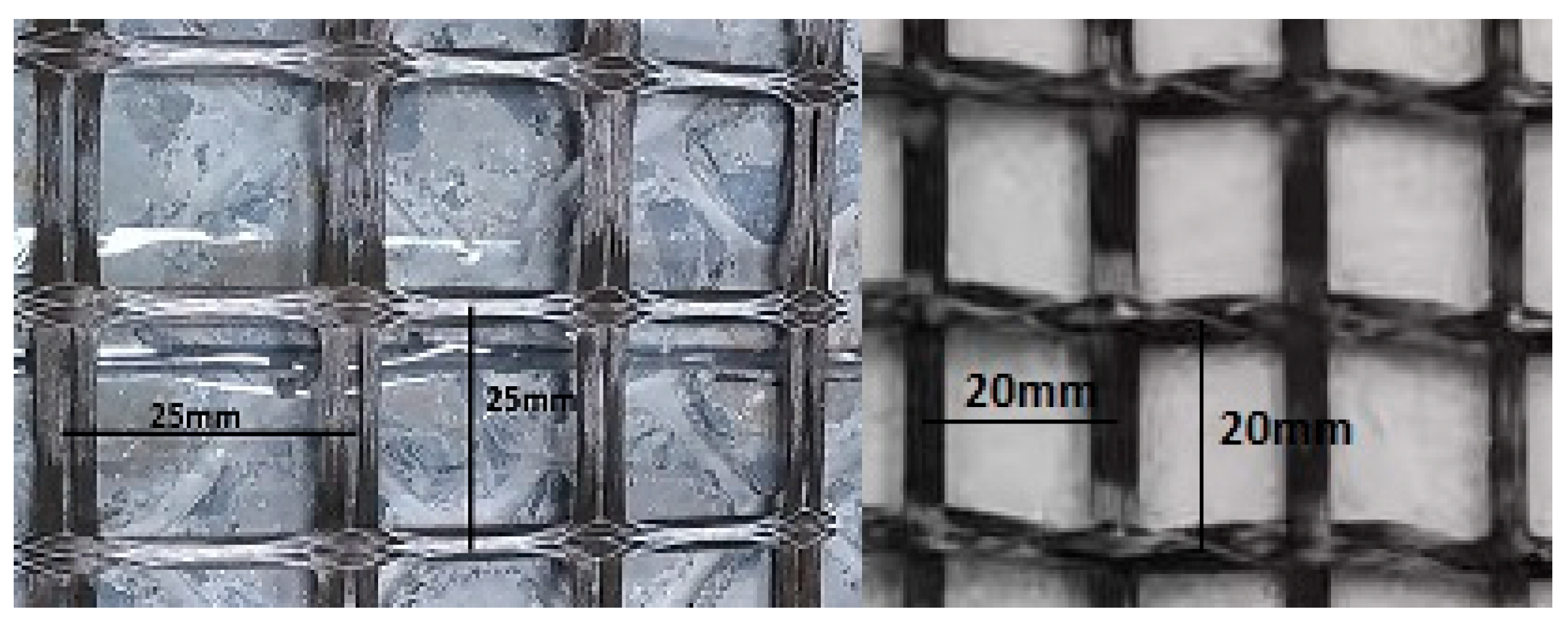

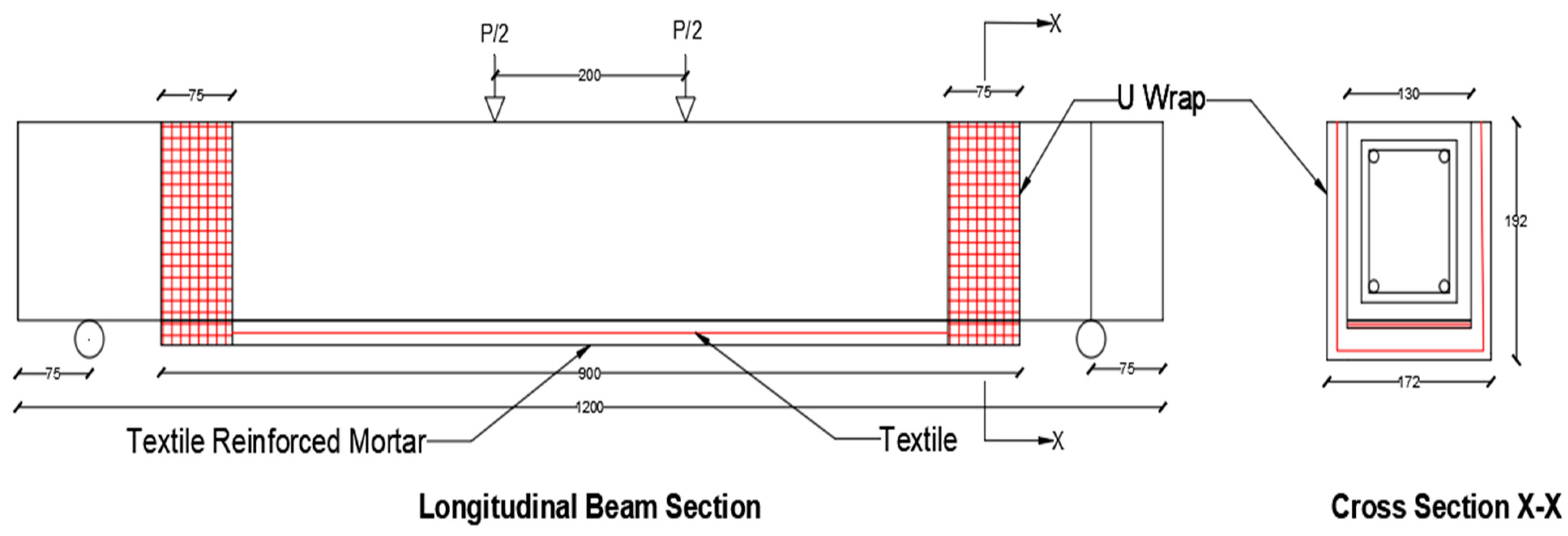





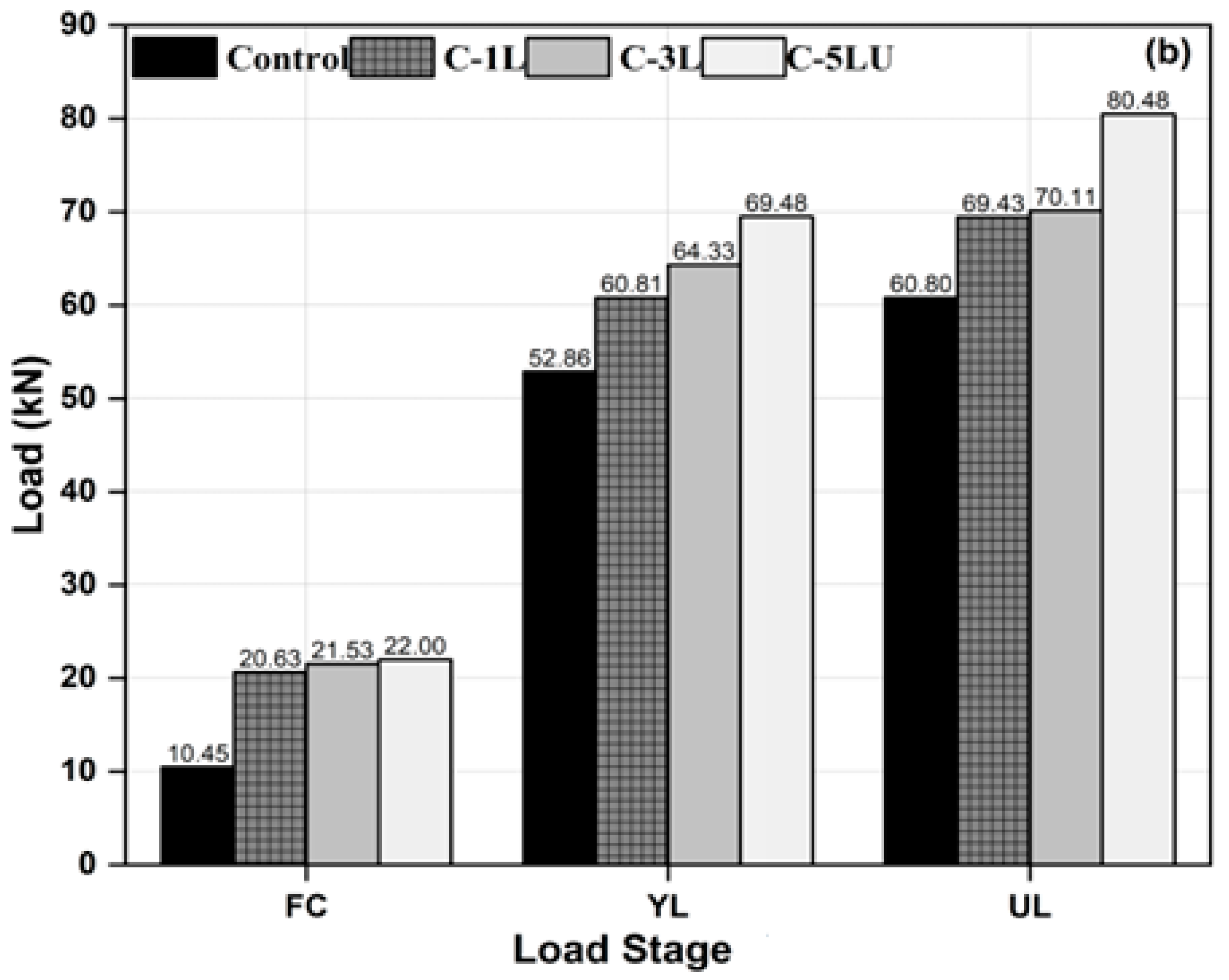

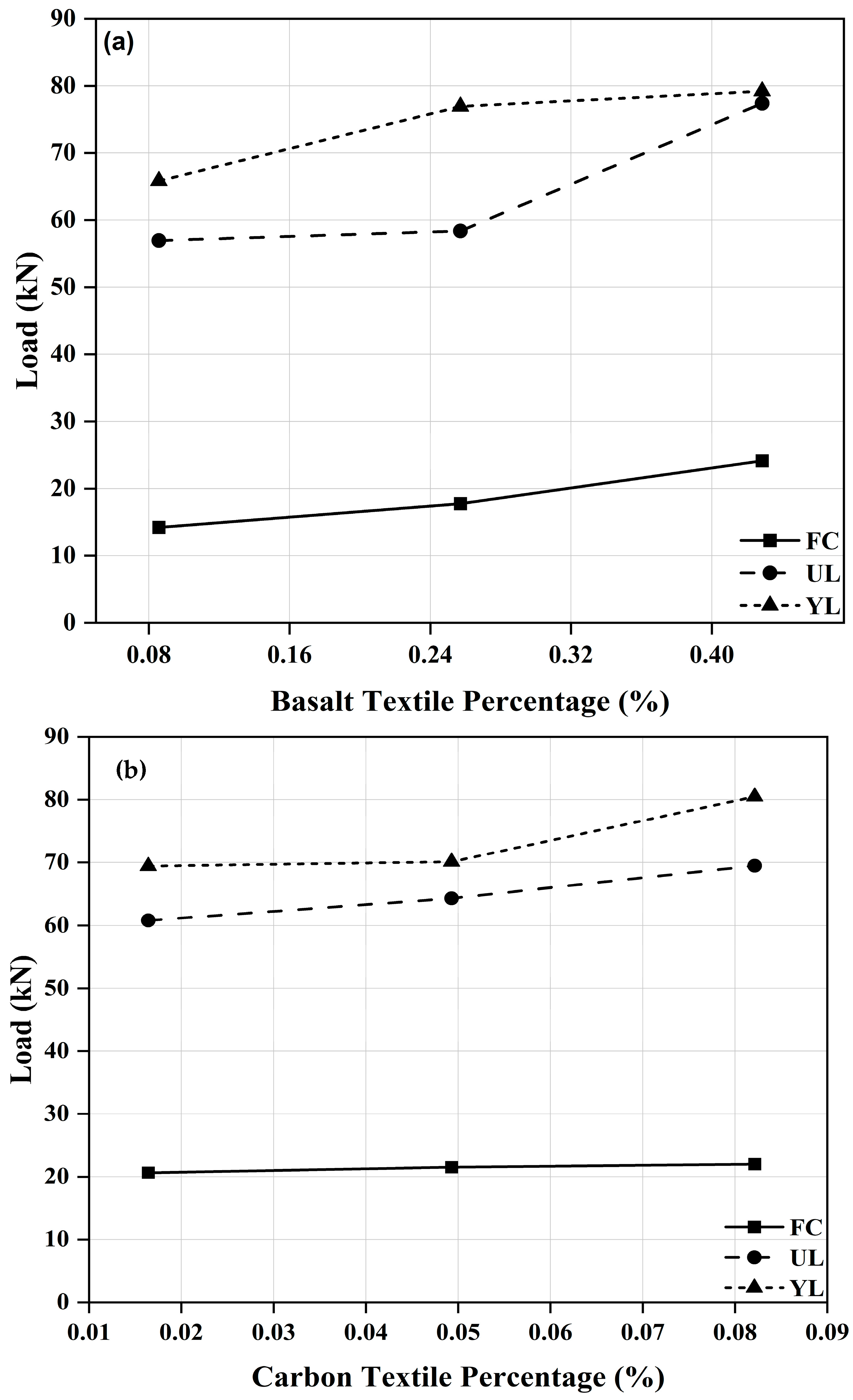
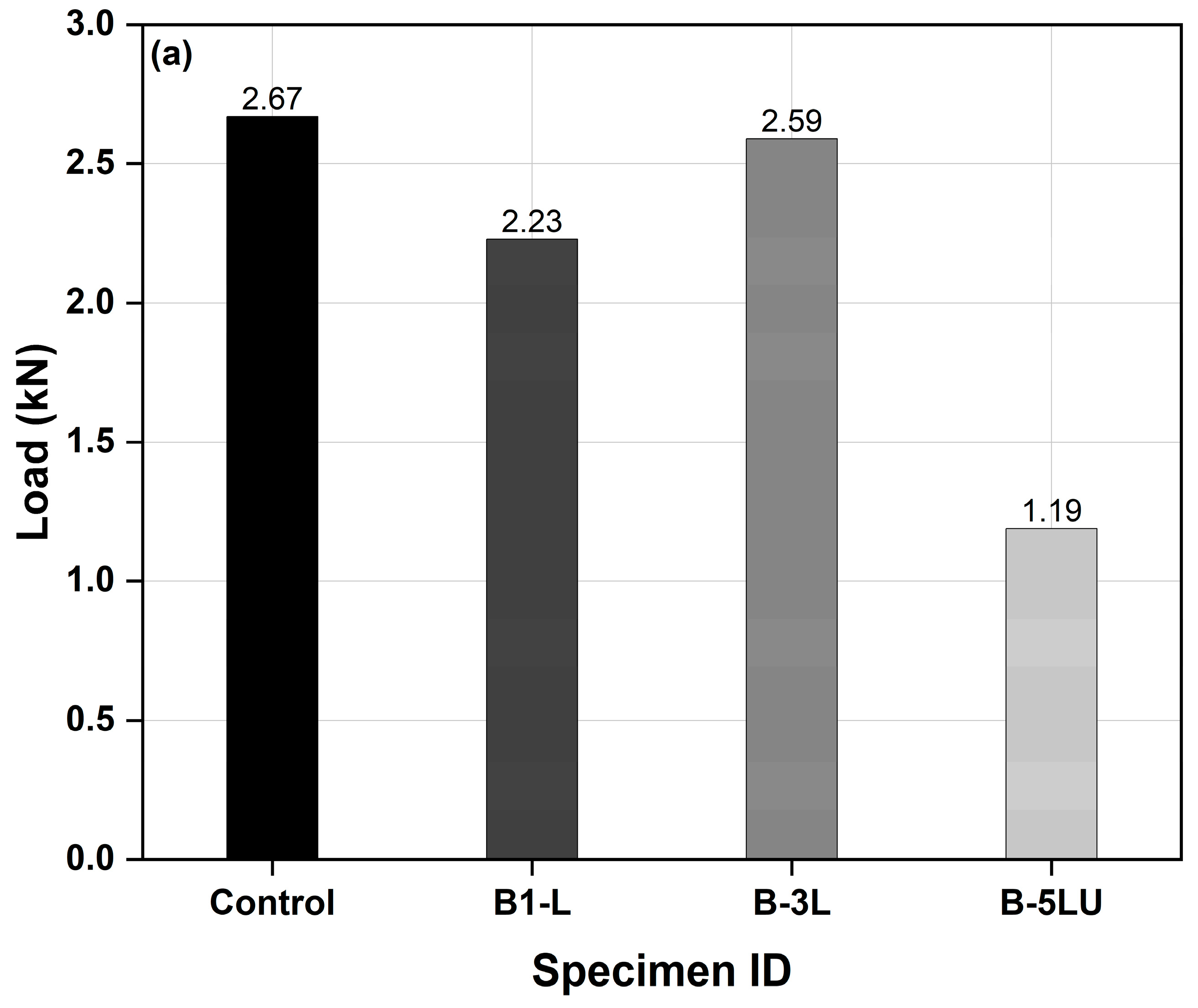
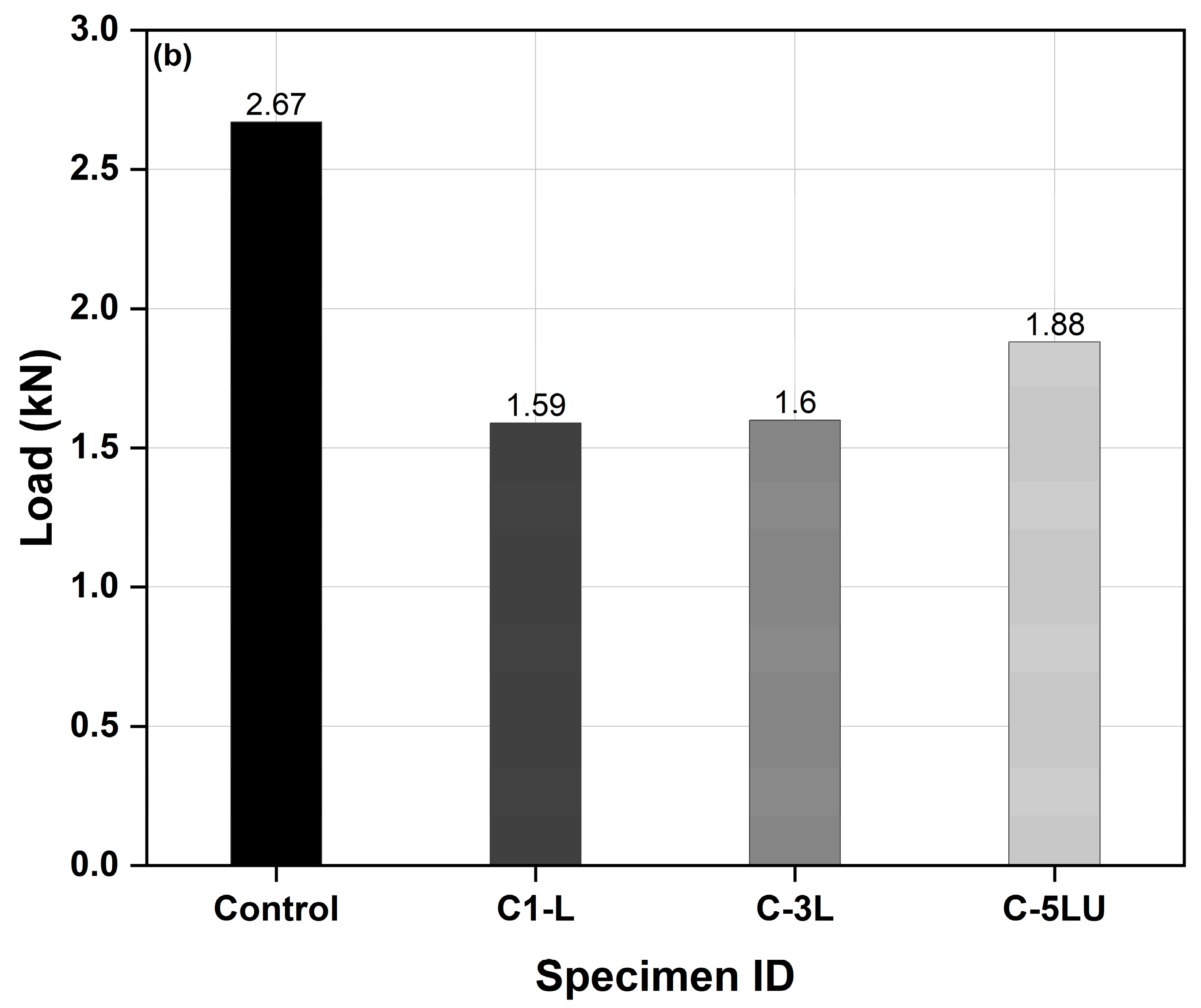
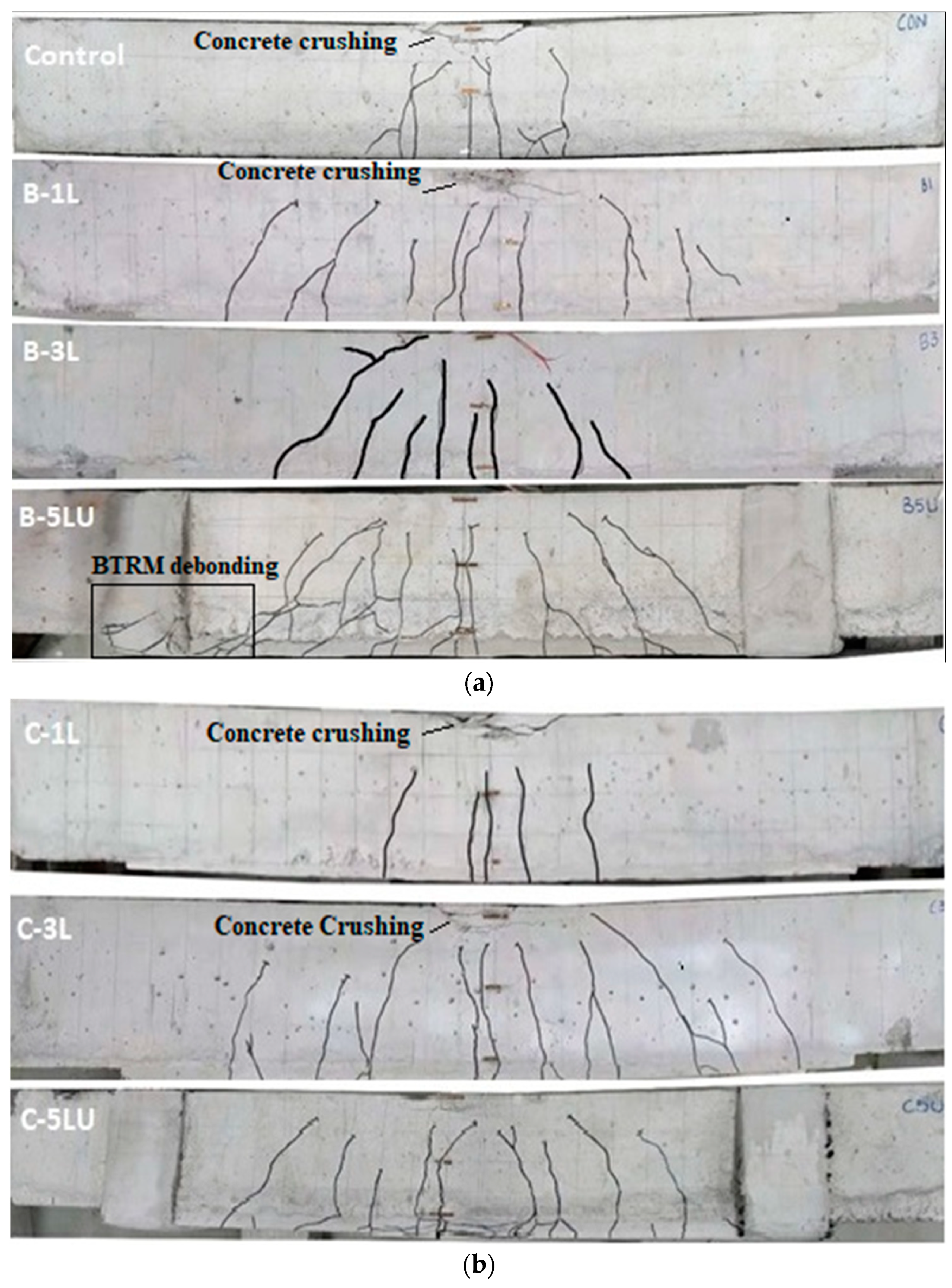

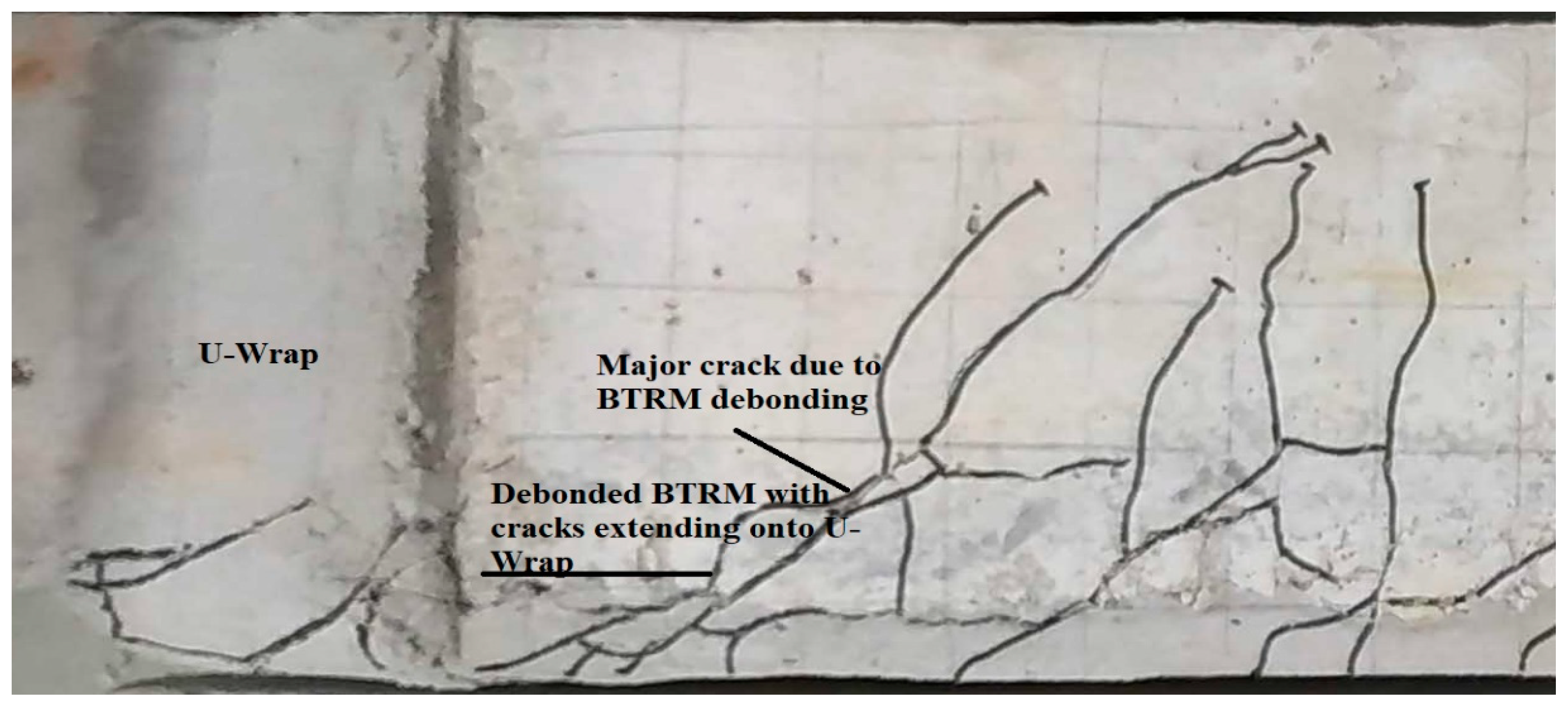

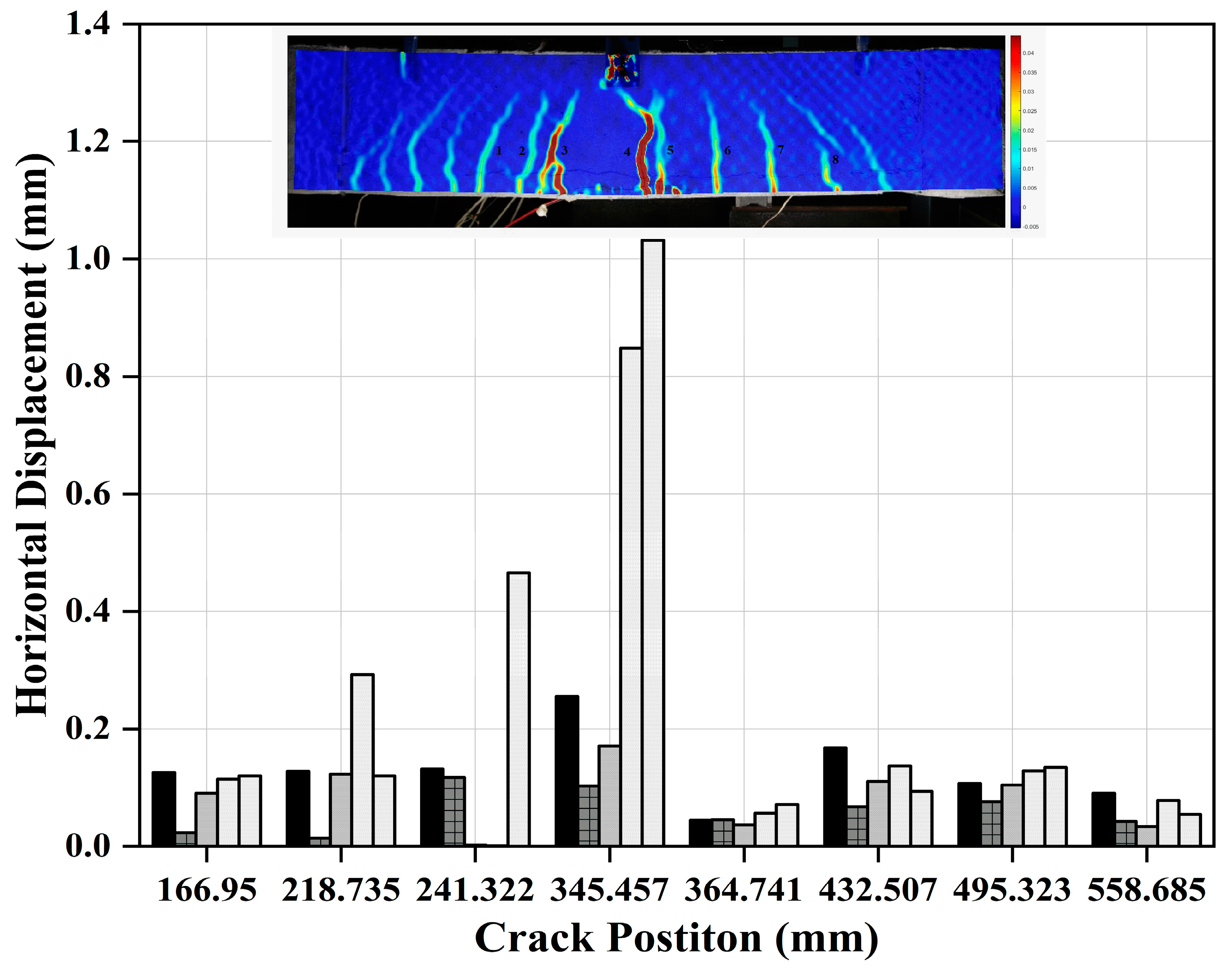
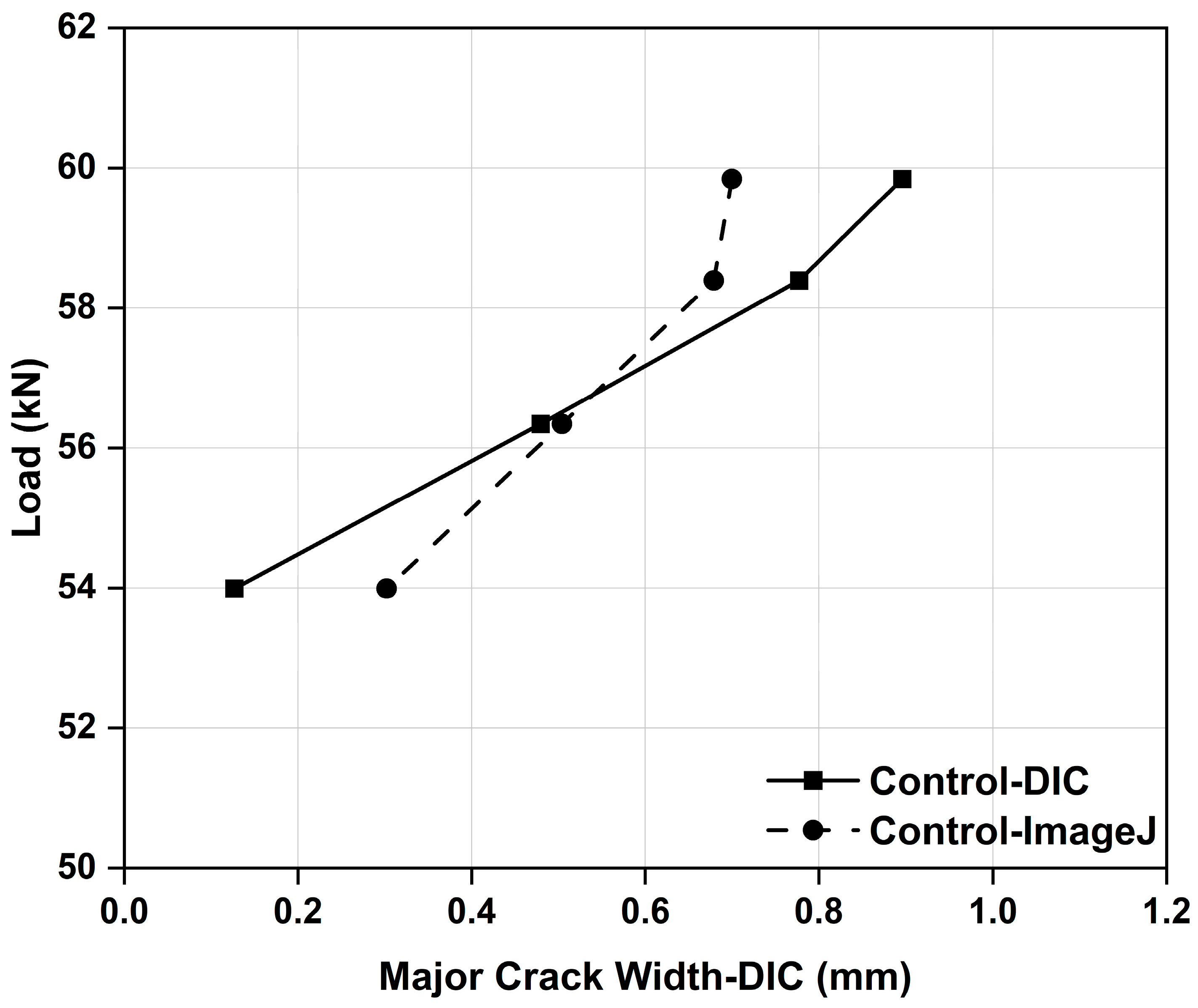

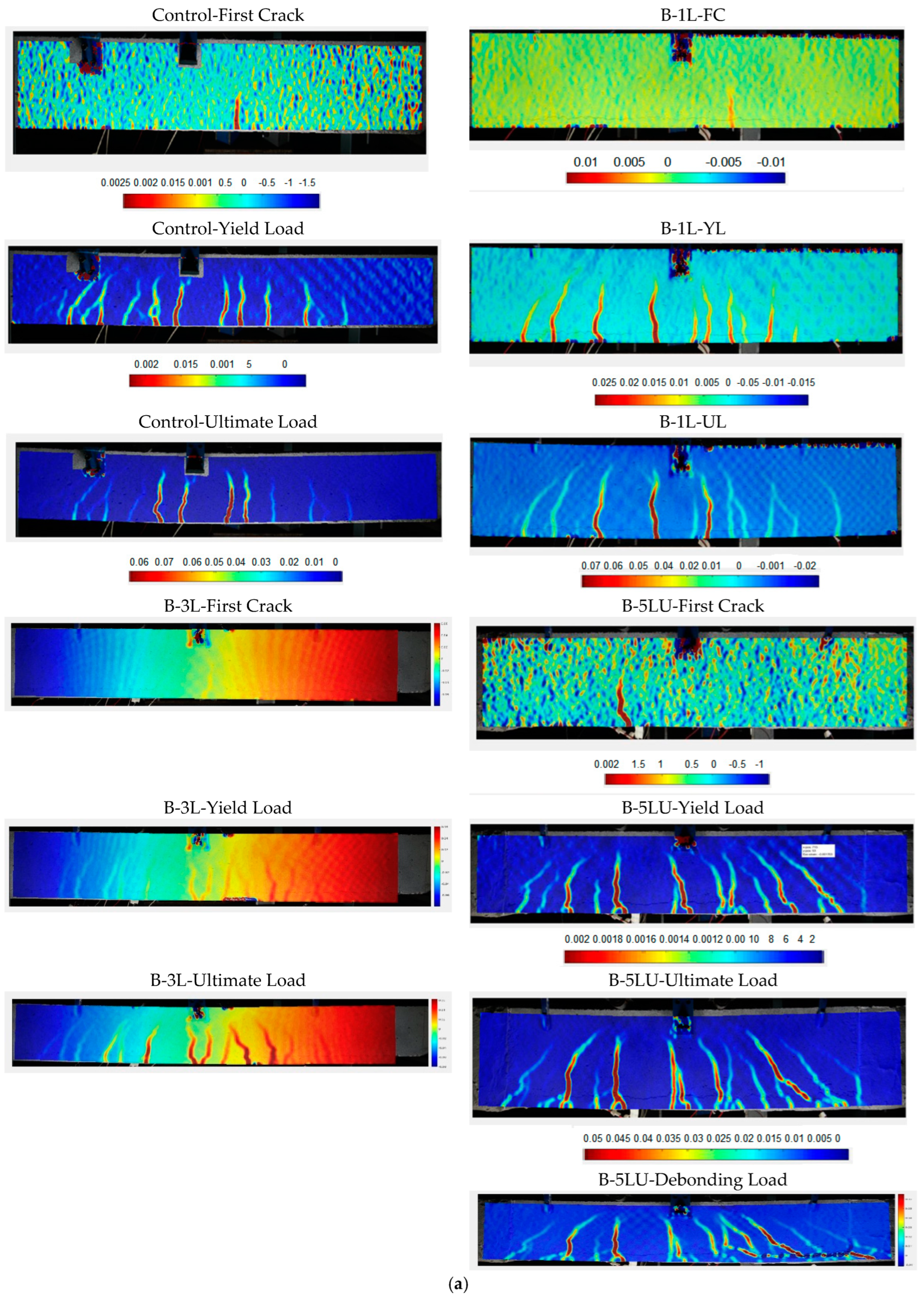
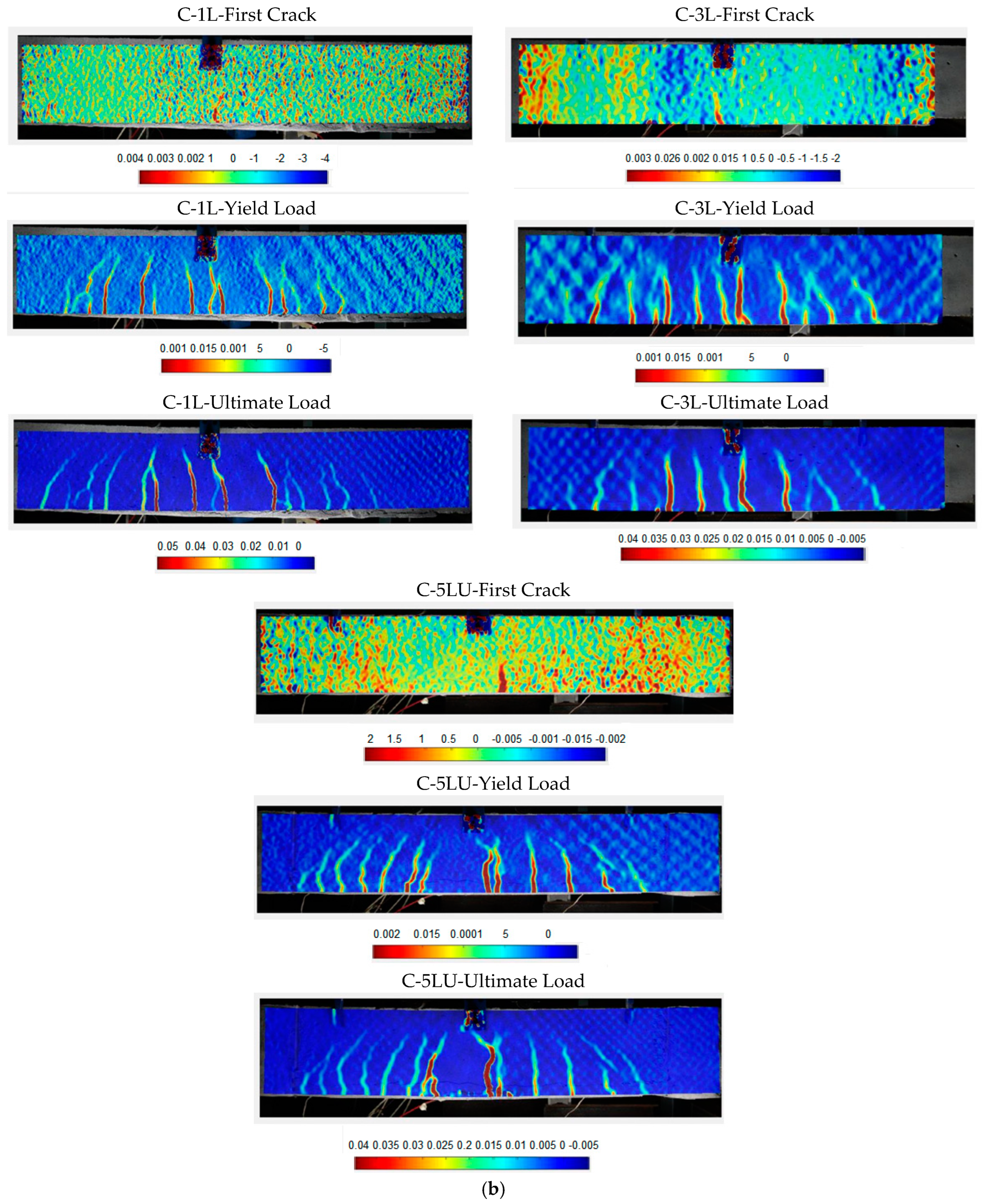
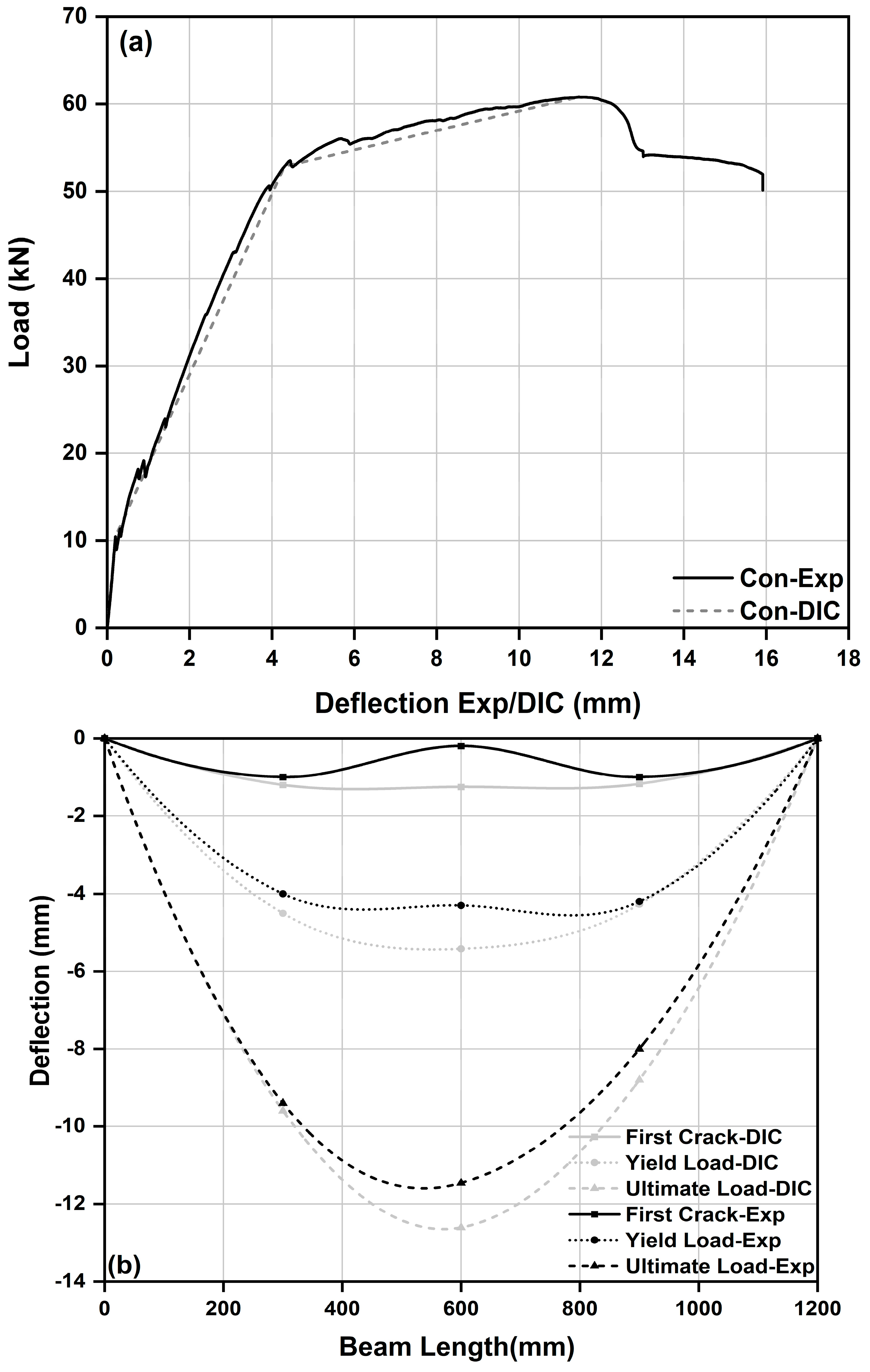
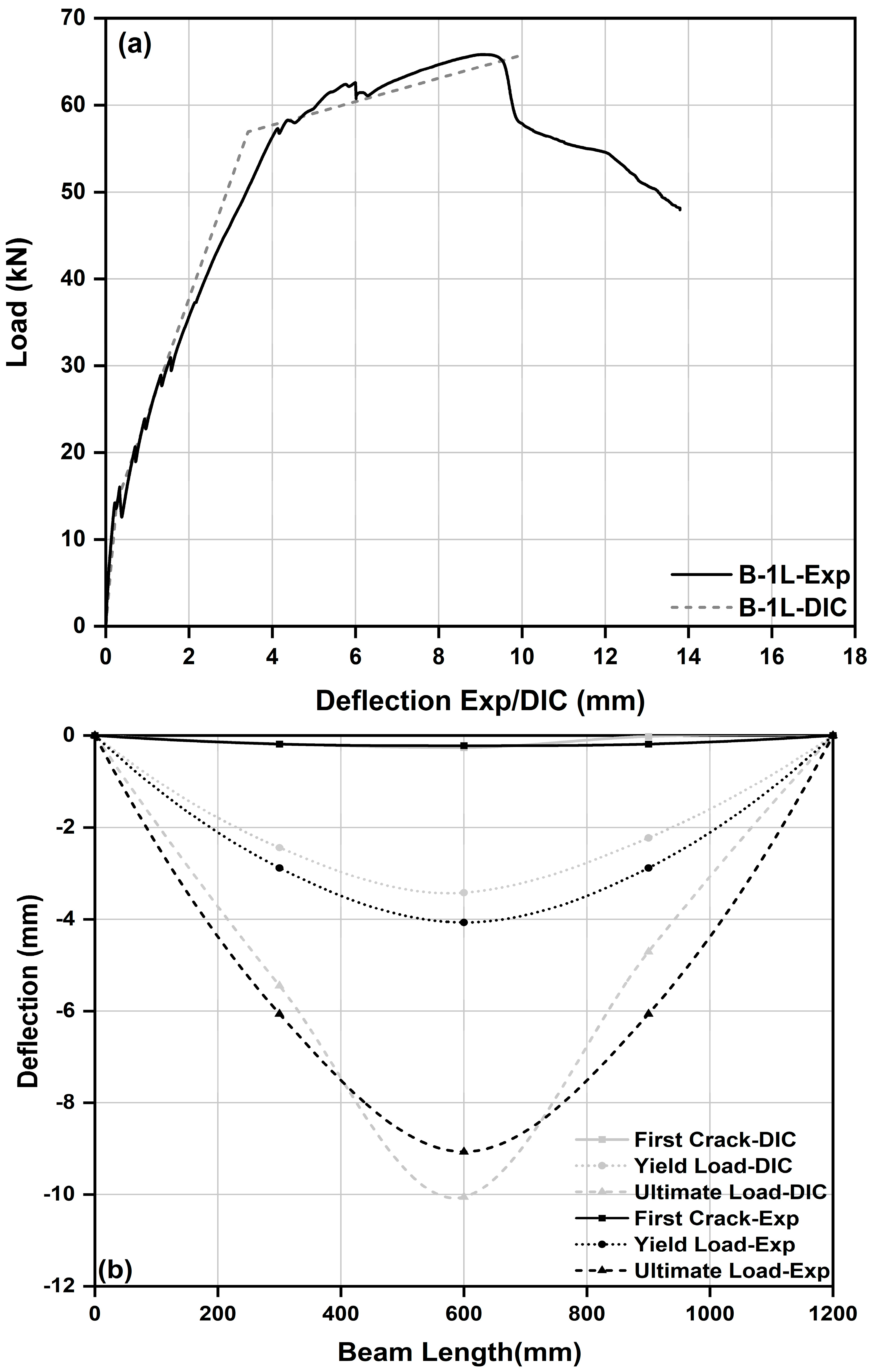
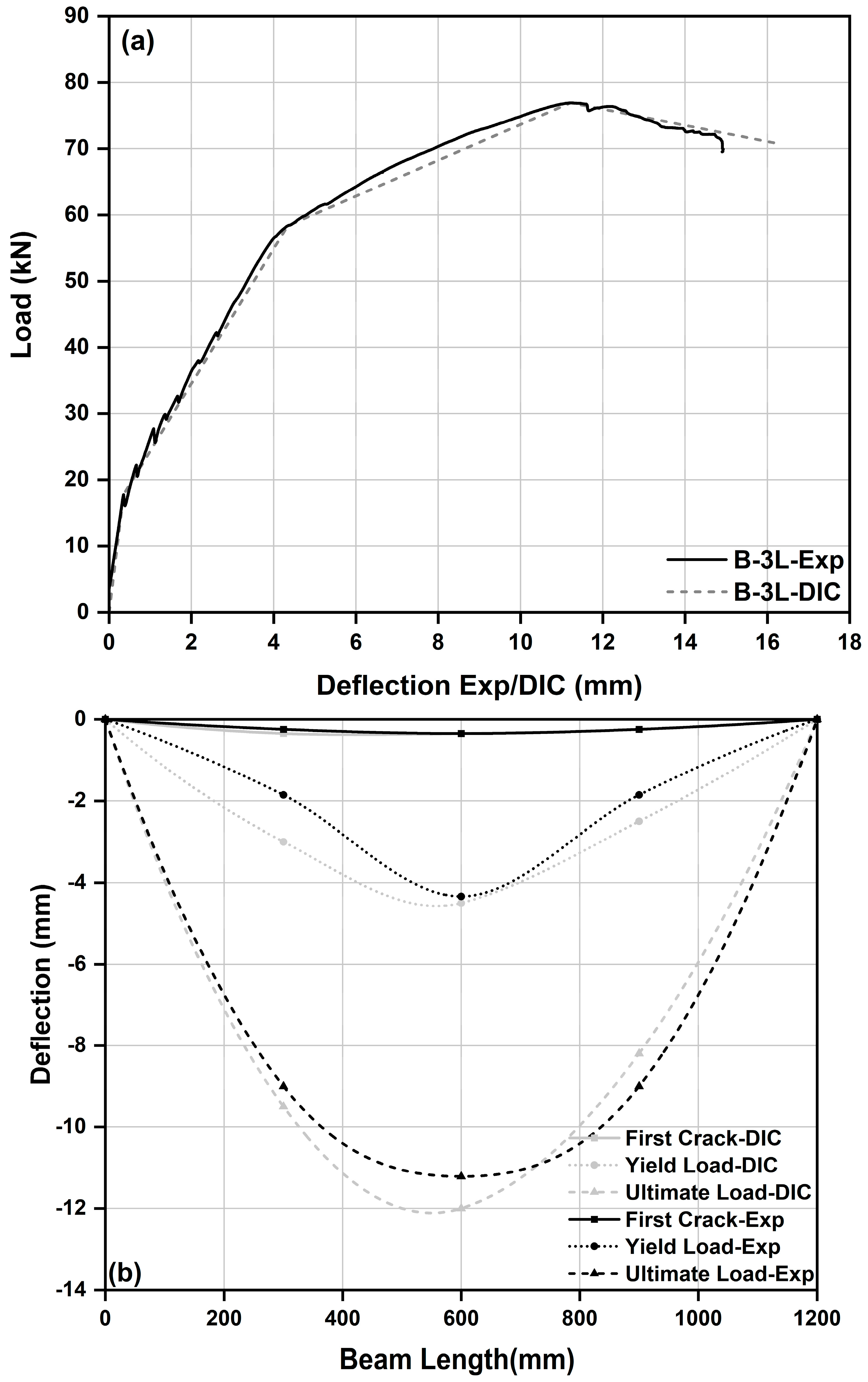



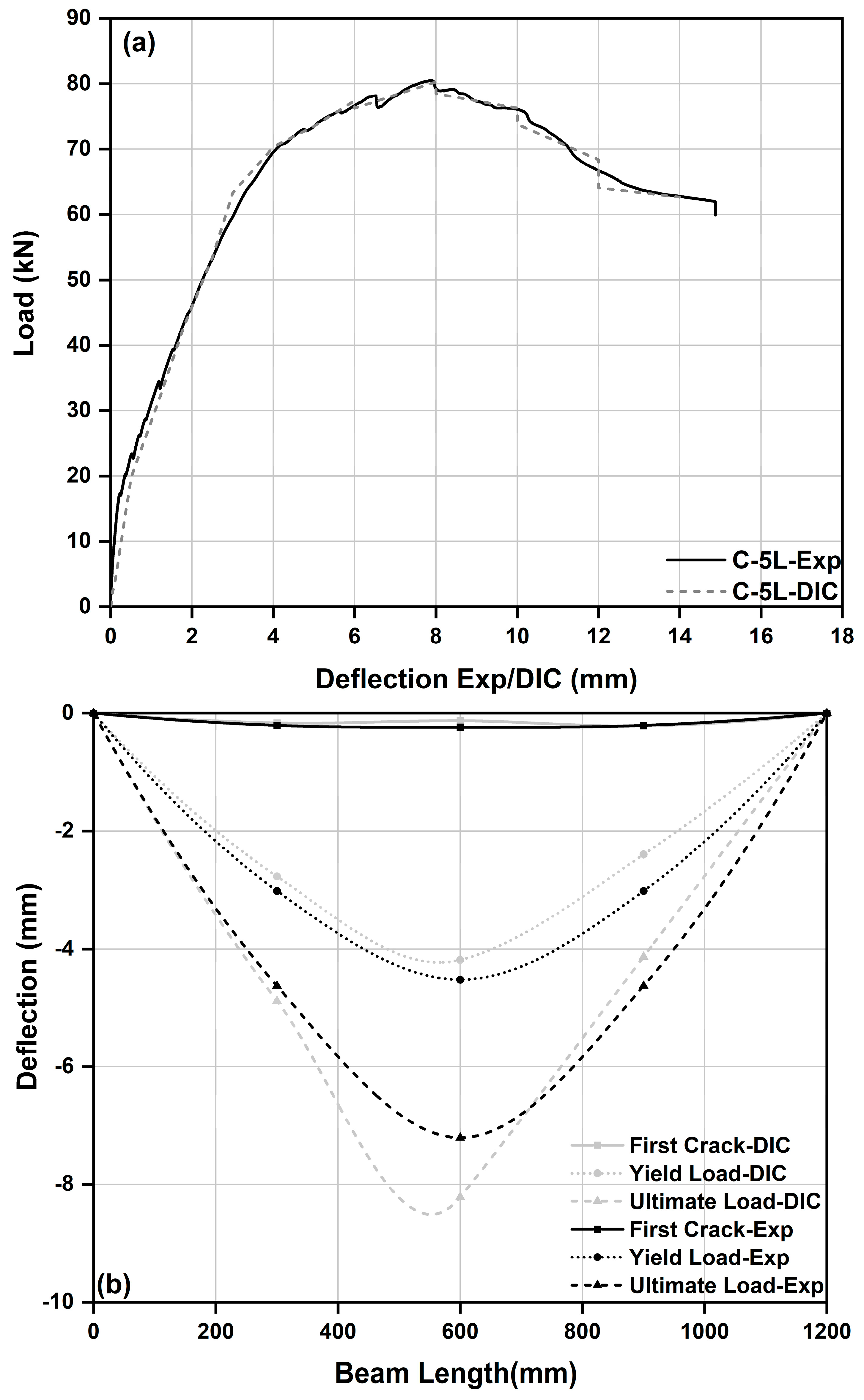
| Basalt | Carbon | |
|---|---|---|
| Weight (without coating) (g/m2) | 350 | 200 |
| Coated | Yes | No |
| Mesh spacing (mm) | 25 × 25 | 20 × 20 |
| Tensile strength (longitudinal) (kN/m) | 50 | 58 |
| Tensile strength (transverse) (kN/m) | 50 | 58 |
| Rupture strain (%) | 0.03 | 0.02 |
| Elastic modulus (GPa) | 89 | 240 |
| Beam ID | Pcr (kN) | Py (kN) | Pu (kN) | Δcr (mm) | Δy (mm) | Δu (mm) | Mcr kN-mm | My kN-mm | Mu kN-mm | ψ kNmm | DI Δu/Δy | EI kN-mm | FM |
|---|---|---|---|---|---|---|---|---|---|---|---|---|---|
| Control | 10.97 | 52.96 | 60.80 | 0.29 | 4.55 | 11.46 | 2.33 | 11.23 | 12.92 | 146.23 | 2.52 | 121.43 | NA |
| B-1L | 14.21 | 56.09 | 65.84 | 0.22 | 4.07 | 9.72 | 3.02 | 11.92 | 14.84 | 143.37 | 2.39 | 166.20 | FSR |
| B-3L | 17.78 | 56.44 | 73.37 | 0.35 | 3.98 | 11.21 | 3.78 | 12.00 | 15.60 | 227.72 | 2.82 | 156.80 | FSR |
| B-5LU | 24.14 | 61.48 | 79.20 | 0.32 | 3.88 | 7.64 | 5.13 | 13.06 | 16.83 | 170.55 | 1.97 | 237.10 | ED |
| C-1L | 20.63 | 60.81 | 69.43 | 0.60 | 5.02 | 7.99 | 4.38 | 13.44 | 14.75 | 134.11 | 1.60 | 147.54 | FSR |
| C-3L | 21.53 | 64.33 | 70.11 | 0.24 | 4.52 | 7.21 | 4.57 | 14.03 | 14.90 | 136.40 | 1.60 | 222.56 | FSR |
| C-5LU | 22.00 | 69.48 | 80.48 | 0.65 | 4.42 | 8.30 | 4.67 | 14.45 | 16.83 | 161.50 | 1.88 | 234.30 | FSR |
Disclaimer/Publisher’s Note: The statements, opinions and data contained in all publications are solely those of the individual author(s) and contributor(s) and not of MDPI and/or the editor(s). MDPI and/or the editor(s) disclaim responsibility for any injury to people or property resulting from any ideas, methods, instructions or products referred to in the content. |
© 2023 by the authors. Licensee MDPI, Basel, Switzerland. This article is an open access article distributed under the terms and conditions of the Creative Commons Attribution (CC BY) license (https://creativecommons.org/licenses/by/4.0/).
Share and Cite
Moy, C.K.S.; Revanna, N. Experimental and DIC Study of Reinforced Concrete Beams Strengthened by Basalt and Carbon Textile Reinforced Mortars in Flexure. Buildings 2023, 13, 1765. https://doi.org/10.3390/buildings13071765
Moy CKS, Revanna N. Experimental and DIC Study of Reinforced Concrete Beams Strengthened by Basalt and Carbon Textile Reinforced Mortars in Flexure. Buildings. 2023; 13(7):1765. https://doi.org/10.3390/buildings13071765
Chicago/Turabian StyleMoy, Charles K. S., and Naveen Revanna. 2023. "Experimental and DIC Study of Reinforced Concrete Beams Strengthened by Basalt and Carbon Textile Reinforced Mortars in Flexure" Buildings 13, no. 7: 1765. https://doi.org/10.3390/buildings13071765





